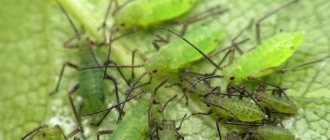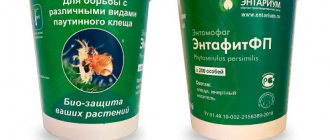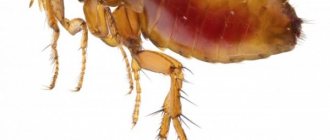About spider mites
Spider mites are arachnid insects that grow to a maximum of 2 millimeters. But usually the size of the baby does not exceed 1 millimeter. As you understand, it is difficult to notice it even with good eyesight. There are orange, red, yellow-green and almost transparent individuals.
Such a tick settles in conditions that are comfortable for it. Usually this is the lower part of the plant leaf, but in the future it can settle in another place.
Prefers to winter:
in small crevices;- on weeds;
- on plant remains.
Insects wake up when it starts to get warmer and the sun warms the air to 10 degrees. Females lay eggs on the underside of a vegetable or weed. Literally a week later, the larvae hatch, which instantly attack the plants and completely drink their juice.
Females show enviable activity - the magazine “Ural Gardener No. 3” for 2021 indicates that on average up to 400 babies can appear at a time. There are about 10–12 such cycles per year. It all depends on the temperature and average humidity in the greenhouse. If nothing is done, you will quickly discover that the entire crop is lost.
Plan for treating plants with drugs
The plant treatment scheme is directly linked to the biological development cycle of the spider mite.
The first spraying is aimed at destroying the bulk of adult individuals. Regardless of the drugs used, the majority of pests (70-80%) will be destroyed.
The second should be carried out a week later, when new individuals hatch from the eggs.
A third spraying is carried out again a week later for final destruction.
Many experienced indoor crop lovers add a fourth spraying to eliminate possible remnants of the population.
Why are spider mites dangerous?
The small parasite feeds only on the juice of plants and flowers, so it does not pose a danger to humans. You should not underestimate the baby, as the pest is very voracious. He does not know how to bite, since his oral apparatus is not adapted for this.
The damage is purely economic, since all plants and vegetables planted in the greenhouse are quickly destroyed if protective measures are not taken in time. Again, the insect cannot tolerate diseases dangerous to humans.
How to recognize
- Spider mites leave cobwebs everywhere, which appear on the bottom of the leaves. Usually almost transparent and incredibly thin, so it does not look like the web of classic spiders.
- The second sign is white dots on the leaves. The foliage, even with constant watering, dries out for no reason.
- Third, some subspecies of spider mites can sometimes be seen if you strain your eyes. They have small eight legs and a red body. The tick does not have wings or whiskers.
When clinical cases occur, any person, even with poor eyesight, will notice the mass of swarming mites.
Why do spider mites settle in a greenhouse?
Amateur gardener Yemets Alena talks about 3 popular reasons why spider mites attack a greenhouse:
- Last season you did not remove weeds.
- The purchased seedlings were accidentally infected with parasites.
- You accidentally introduced pests.
If you find a pest in the first year, then it must be destroyed by all means. Without doing this, there is a big risk of only worsening the situation.
What agricultural crops does it settle on?
In the greenhouse, spider mites most like to settle on cucumbers. However, if they are not there, they can also eat:
Tomatoes
Pepper
Eggplant
Melons
All kinds of cereals
The tick can also settle in beds, but it doesn’t particularly like them, because it lives much better in a greenhouse.
Folk remedies
It is best to start fighting ticks using traditional methods. Not only will the plants not suffer from them, but nothing will happen to humans either.
Ammonia
- Fill a bucket of water and pour 30 milliliters of ammonia inside.
- Mix thoroughly.
- Water the stems and leaves regularly.
- Also constantly wipe the walls and doors of the greenhouse with the resulting mixture.
Tomato tops
The tomato tops that remain after harvesting will be an excellent tool in the fight against the pest.
You need to take about 0.5 kg of it and fill it with a bucket of boiling water. Further:
- place the bucket with tops on the stove and boil for 30 minutes;
- strain the resulting mixture;
- add soap shavings to it.
By watering with this mixture, you will get rid of not only ticks. In addition to them, it will be possible to destroy the ubiquitous aphids.
Fumigation
You will have to wait until the end of the summer season - usually this happens in early November.
We will fumigate with sulfur bombs. Further:
harvest the remaining harvest;- water the soil, getting rid of even the tiniest weeds;
- put on a gas mask and protective gloves;
- Moisten the surfaces thoroughly with water;
- place the checkers on stones or metal surfaces and then set them on fire;
- close the door to the greenhouse for several days;
- After this, you need to ventilate the room.
Dry wormwood
Collect a kilogram of wormwood and chop the stems.- Fill the grass with 10 liters of water.
- Cover the container with a lid and keep it out of the sun for 2 days.
- Place the bucket on the fire and wait until it boils.
- The liquid should bubble for ¼ hour.
- Dilute the resulting mixture with a bucket of water and begin spraying the greenhouse plants.
Chemical methods
If insects cannot be controlled with folk remedies (or you started the fight too late), chemical methods should be used. But you need to use them extremely carefully so as not to damage the plants and not get poisoned yourself.
Plant Pin
It destroys not only adults, but also their eggs.
The drug looks like special sticks. We will poison ticks like this:
- take a stick and stick it into the ground at a distance of 2 centimeters from the stem (this should be done on each plant);
- water the plant.
After this, the plant pin will be absorbed into the ground. Insects will feel the effect of the drug within a few days. Usually they talk about two days, but most often you need at least 3-4 days.
Fitoverm
One treatment is enough for spider mites to immediately stop reproducing. But the remedy is suitable only when there are still few insects.
How to use:
- pour 2 liters of water into a bucket;
- open the ampoule of the drug and mix it in a bucket;
- then pour more water and mix thoroughly again;
- pour the resulting mixture next to the plants.
Aktellik
The drug is poisonous to humans, so you need to wear gloves, a protective mask and a reliable headgear. If possible, wear protective clothing. You can use a robe. When diluting the drug, act only strictly according to the instructions. It is forbidden to deviate from it.
At the same time, Candidate of Agricultural Sciences Tatyana Steinert says that due to its toxicity, the drug is now used mainly in industrial greenhouses.
Actellik is used as follows:
- dilute the drug in a small amount of water;
- bring the emulsion concentration to 1 mm per 1 liter. working solution;
- Apply the resulting solution generously to the plant leaves.
Soap solution
It is possible to get rid of ticks at home using a soap solution. Traditionally, laundry soap is used for this, but sometimes sulfur-tar soap or green soap is chosen. Some people recommend using a little detergent diluted with water instead of soap.
Treat any plants with soap - both indoor and greenhouse. For the procedure, 200 g of laundry soap is grated and dissolved in a bucket of warm water. After the solution itself has been prepared, you need to take the affected flower and gently wipe the leaves and stems with a sponge soaked in the solution. You need to remember that getting this product on the roots will have a very detrimental effect on your flower (it may even lead to its death), so the procedure is carried out extremely carefully. When the procedure is completed, the flower is left for several hours (3-4), and then the remaining foam is washed off well. After the procedure, it is recommended to cover the flower with a plastic bag to maintain moisture levels.
Sulfur-tar soap has also established itself as a reliable remedy that can really get rid of spider mites. You will need less of it than household or green - only 100 g per bucket of water. It is recommended to carry out the treatment every week, only 2-3 times.
Some gardeners talk about the good effectiveness of green soap. Green soap is a liquid soap that is designed specifically to combat a variety of parasites that threaten your flower garden. A solution of green soap is used, but you can combine it with other drugs to increase effectiveness. However, opinions on the usefulness of green soap are divided: some argue that it is only suitable for preventive treatment, and will not help if the pest has completely occupied your flower garden.
Prevention of pest occurrence
In addition to means of combating spider mites, comprehensive prevention is also important.
It can be divided into 3 stages:
- in the spring - preparation;
- all season - current;
- before wintering - final.
In the spring, you need to clean the room after wintering and sterilize the soil. For this:
- wash the greenhouse structure with soapy water, after adding chlorine to it;
- dig up the soil to 25-30 cm;
- treat it with boiling water;
- cover the soil tightly with film for 3 days;
- fumigate the room with sulfur bombs;
- spill the soil with a one percent manganese solution.
During ongoing prophylaxis:
- high humidity must be maintained in the greenhouse;
- plant plants at a distance of one and a half meters;
- regularly inspect planted vegetables;
- remove parts of leaves on bushes;
- mulch the soil;
- spray the soil and plants with onion infusion.
Autumn:
- completely remove plant debris and various auxiliary structures;
- Dig the soil carefully, adding lime or phosphate fertilizers.
How to protect flowers from mites
Preventative measures are much more effective than controlling the parasite. The tick cannot tolerate moisture. Therefore, it is important to maintain indoor air humidity. For indoor flowers, you need to regularly take a warm shower.
Pests settle on healthy plants much less frequently. It is necessary to monitor the condition of indoor flowers. Remove dying dry leaves in a timely manner. Make sure that no weeds appear in flowerpots and flowerpots. Feed flowers with useful microelements in a timely manner.
When transplanting plants into new flowerpots, changing and adding soil, all precautions must be taken. The soil from the garden must be sanitized. You can calcinate it, pickle it with specially designed compounds.
You should not buy soil of unknown origin. In specialized stores they control the quality of the product. By purchasing bags of soil from unknown manufacturers, it is easy to introduce a variety of pests and pathogens into your home.











